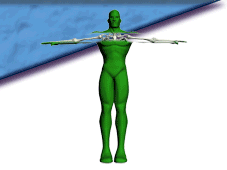Hip Rotation Explanation
The following is excerpted from an article by Dr. Young published in the Journal of The North American Naprapathic Assoc. in 1998
 Many activities can result in significant right-to-left pelvic asymmetry, commonly
referred to in the Naprapathic and Chiropractic communities as "Hip Rotation". Such
activities, especially if they are vigorous and new ones, open up the pelvis and its' related
muscles to imbalance and pain. The most common muscles effected by certain activities
were studied and are listed below. Keep in mind that the activities that cause problems
are generally untrained-for activities, and that these are generalizations and, as such,
invite exceptions.
Many activities can result in significant right-to-left pelvic asymmetry, commonly
referred to in the Naprapathic and Chiropractic communities as "Hip Rotation". Such
activities, especially if they are vigorous and new ones, open up the pelvis and its' related
muscles to imbalance and pain. The most common muscles effected by certain activities
were studied and are listed below. Keep in mind that the activities that cause problems
are generally untrained-for activities, and that these are generalizations and, as such,
invite exceptions.The iliopsoas muscle (hip flexor) - hurtling and stair-stepping
The hamstring muscle - sprinting sports and skiing
The piriformis and gluteal muscles - running and stair-stepping
The tibialis anterior muscle - skiing and distance walking
The calf muscle - volleyball and basketball
The quadratus lumborum muscle - Bending activities
The obturator muscle - pivoting sports like basketball
The most common complaint with hip rotation is unilateral low back/pelvic and leg pain when standing for longer than a very few minutes. This discomfort is alleviated almost immediately by sitting, a characteristic that helps differentiate the leg pain from neurologic sciatica. Walking also relieves the symptom.
Hip rotations, especially when great, often correlate with chronic sacroiliac sprain. This may be a low-grade type discomfort that appears and disappears almost each day and is located unilaterally around the area of the P.S.I.S. (the area you would place your palms if you placed them on the back of your hips near you low back). The patient should be evaluated for S.I. strain and shown exercises and given treatment and support activities for this, including a heel lift in the shoe if this proves applicable.
Return to the Articles Page
Return to the Where's Your Pain? Page



